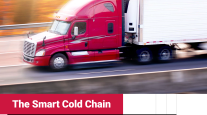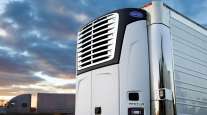Senior Reporter
Cold Transport Moves Further Into Electrification

[Stay on top of transportation news: Get TTNews in your inbox.]
LONG BEACH, Calif. — North America has the most advanced cold chain on the planet, some say. Now the technology for cooling transported goods is adapting. It is moving further into electrification and other means to spur deployments of zero-emission transport refrigeration units, manufacturers said.
Industry and government representatives addressed the changes during the TRU Workshop at Advanced Clean Transportation Expo (ACT) Expo, which runs through Sept. 2.
Thermo King, a unit of Trane Technologies, announced Aug. 30 it will invest $100 million to deliver a fully electric product in every segment of the cold chain by 2023.
We are a proud sponsor of this year's @ACTExpo!
Learn more about evolve - our new brand representing our all-electric product line for the truck, trailer, bus, rail, and marine markets: https://t.co/MdtREdLeso #electrification #transportation pic.twitter.com/bkvHqdfvI1 — Thermo King Corporation (@thermoking) August 31, 2021
The emerging products will fall under the Evolve brand name.
“It is designed to spearhead everything we are doing,” from light vehicles through longhaul and regional trailer products, said Paul Kroes, Thermo King Americas strategic insights leader.
The shift also will cover rail, air and marine transport.
Solutions will be available in the Americas by 2025, according to the Swords, Ireland-based company.
Kroes suggested 10-20% of the trailer market would transition to electric by the end of the decade and about 50% by 2035.
And this comes as California is readying zero-emission requirements for TRUs sold or operated in the state by Dec. 31, 2029.
David Kiefer, director of product management for Carrier Transicold, said the California Air Resources Board was working on those regulations “at a pragmatic speed.”
A hearing on TRUs is scheduled for Sept. 23 in Sacramento, Calif., to review comments on proposed amendments to the Airborne Toxic Control Measure for In-Use Diesel-Fueled TRUs and TRU Generator Sets, and Facilities Where TRUs Operate (TRU ATCM).
“California is done with combustion. We are going to show the world the path forward,” said Lea Yamashita, air pollution specialist at CARB, where she is managing the agency’s effort to change TRUs.
Day 2 at #ACTexpo! We are so excited for the industry to convene and explore advanced technology commercial vehicles, hear keynote speakers discuss the hottest trends, and attend sessions covering the latest innovations in the clean transportation industry. #CleanTransportation pic.twitter.com/hUuNMslzog — Advanced Clean Tech News / ACT Expo (@ACTExpo) August 31, 2021
“Our equipment is going to run on electricity,” Kiefer said. “It doesn’t really matter where that electricity comes from.”
That could be from a fuel cell, shore power or a battery recharged by regenerative braking on a trailer. “Ultimately, at some point as we go to electric vehicles, we will either share a battery or share a charger,” he said.
Clean Cold Power President Rimas Kapeskas advocated cooling to very low temperatures using nitrogen.
“We are leveraging the natural properties of liquid nitrogen to power what we refer to as two separate phases of cooling,” Kapeskas said. “Nitrogen is one of the coldest substances on Earth. It is minus 320 degrees Fahrenheit [at its lowest]. When it goes through a phase change from a liquid to a gas, it expands 700 times. We are using that property to create something new in the TRU industry.”
He added that with nitrogen, there are no batteries to buy, dispose of or find the infrastructure to recharge with.
Cryogenics for transportation has been around since the 1960s with direct injection into the cargo space. Phase 2 involved indirect cooling with an evaporator coil. The company’s latest effort initially cools using the inherent coldness of cryogenic liquid nitrogen, then a conventional refrigeration cycle is powered by a Dearman engine.
How a Dearman engine works, according to the company, is:
- Cold liquid nitrogen is piped through heat exchangers to provide rapid cooling in the first refrigeration circuit.
- The now warm nitrogen is fed into the Dearman engine (what the company calls an ingenious yet simple piston expander) and mixed with a heat exchange fluid to increase efficiency as it expands, generating power.
- The Dearman engine powers a second refrigeration cycle and generates electricity to power fans and other systems, allowing fully independent operation.
- The heat exchange fluid is recovered and recycled, and the nitrogen is returned to the air.
A 10-minute fill of liquid nitrogen into a trailer tank can last three or four days depending on loads and duty cycles, the London-based company noted.
Meanwhile, Robert Koelsch, president of Advanced Energy Machines, said the company gets heavily involved in infrastructure design for its customers.
“Our mission is to take not only your TRUs to zero emissions, but your whole facility off the grid,” he said. “We do that through battery-electric storage, and we do that through solar.”
He said battery-electric storage systems will be the next big technology.
Advanced Energy Machines products include a solar-powered generator system with enough capacity to run a two- or three-zone refrigerator-freezer delivery trailer ranging in size from 28 to 53 feet, according to the Mesa, Ariz.-based company. The 100% solar product is now offered with new patent-pending refrigeration so efficient it is rivaling the watt/btu capability of ammonia refrigeration systems, it said. This efficiency enables the design to rely upon solar charging to run the reefer system when combined with lithium battery technology.
“And yes, we can cool ice cream,” he said, referring to a cold chain benchmark.
Want more news? Listen to today's daily briefing below or go here for more info:




